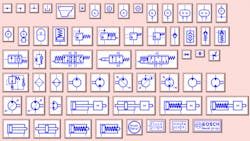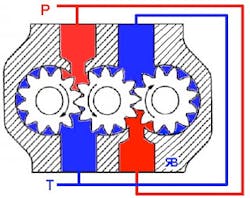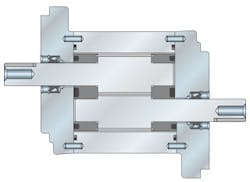A website based in the Netherlands has some great graphics showing how fluid power (hydraulic and pneumatic) components work. Visuals are simple, two-dimensional drawings, but color coding and animation are effective at conveying basic principles.
So if you have colleagues who need some basic training in fluid power or have trouble visualizing how things work, you might want to refer them to this site.
However, there's more to this site. It describes a three-gear pump (at right, top). Gear pumps and motors can already transmit extremely high power in a small volume, and this concept seems to take it further: increase output by 100% while increasing the size only 50%. In fact, as long as the components are strong enough, you could probably use this concept to make a three-gear motor with twice the torque capability of its conventional counterpart.
A similar concept along these lines was described in a short article I edited earlier this year — the February 2011 issue, to be exact. In the article, I describe how a mechanical engineer modified a standard gear motor to provide two outputs (at right, bottom). He did this by replacing the idler gear with one having a shaft extension. Of course, he also had to use a side plate to accommodate the second output shaft. But this was done successfully, and both output shafts run at exactly the same speed. This could prove useful in many applications, I'm sure.
About the Author
Alan Hitchcox Blog
Editor in Chief
Alan joined Hydraulics & Pneumatics in 1987 with experience as a technical magazine editor and in industrial sales. He graduated with a BS in engineering technology from Franklin University and has also worked as a mechanic and service coordinator. He has taken technical courses in fluid power and electronic and digital control at the Milwaukee School of Engineering and the University of Wisconsin and has served on numerous industry committees.
Sign up for our eNewsletters
Get the latest news and updates

Leaders relevant to this article:


